Welcome to the Rooted Connections FAQ page, where we aim to provide answers and resources for our esteemed Deaf and DeafBlind community, as well as employers and business organizations seeking effective communication solutions.
As a dedicated company specializing in translation services, we understand the unique challenges faced by individuals with hearing and sight impairments, and we are here to bridge the communication gap. With our expertise, we strive to empower both individuals and organizations, ensuring equal access to opportunities and fostering inclusivity.
In this comprehensive FAQ, we address the most commonly asked questions while offering valuable resources to help you reach your maximum potential. Let us embark on this journey together, fostering connections and embracing diversity every step of the way.
A deaf interpreter, also known as a certified deaf interpreter (CDI), is a highly skilled professional who specializes in facilitating communication between individuals who are Deaf or DeafBlind and those who have hearing abilities. Unlike hearing interpreters who work with spoken languages, deaf interpreters are fluent in sign language and possess a deep understanding of the Deaf culture and community. They play a vital role in situations where the language or communication needs of the deaf individual are complex, such as when the deaf individual has limited sign language skills, uses a unique signing system, or has additional cognitive or sensory disabilities. Deaf interpreters utilize their expertise to accurately convey the intended meaning, cultural nuances, and emotions of the messages being conveyed, ensuring effective communication for all parties involved. Their invaluable contributions enhance accessibility, inclusivity, and equal participation in various domains, including education, healthcare, legal settings, and more.
The decision between a deaf interpreter or a hearing interpreter depends on various factors, including the specific needs and preferences of the individuals involved in the communication process. Here are some considerations to help determine which type of interpreter may be most suitable:
Language Proficiency: Assess the language skills of the deaf individual. If they have limited sign language skills or use a unique signing system, a deaf interpreter with specialized knowledge and expertise in accommodating diverse communication needs may be beneficial. If the individual is fluent in sign language and comfortable communicating with a hearing interpreter, a hearing interpreter could be sufficient.
Cultural Competence: Consider the cultural and linguistic nuances involved in the communication. Deaf interpreters have an in-depth understanding of Deaf culture, which can enhance communication by accurately conveying the cultural and contextual elements that may be missed by a hearing interpreter.
Complexity of Communication: Evaluate the complexity of the communication situation. Deaf interpreters are often utilized in situations where the communication is intricate, such as legal proceedings, medical consultations, or educational settings involving technical or specialized terminology.
Sensory Considerations: If the deaf individual is also visually impaired or DeafBlind, a deaf interpreter with specialized training in tactile signing or other communication methods tailored to individuals with dual sensory impairments may be necessary.
Personal Preference: Consider the preferences of the deaf individual. Some individuals may have had positive experiences working with a particular type of interpreter in the past and may express a preference for either a deaf interpreter or a hearing interpreter.
Ultimately, the decision should be made collaboratively, involving the deaf individual, service providers, and relevant stakeholders, to ensure that the communication needs of all parties are met effectively and inclusively.
Rooted Connections Deaf interpreters possess exceptional skills, experience, and attributes that set them apart in our profession.
Mastery of Sign Language: We have a deep and comprehensive knowledge of sign language. We are fluent and highly proficient in various sign language systems, including regional variations and specialized signing used within specific communities or domains.
Linguistic Expertise: We possess a strong understanding of linguistics, including the structure, grammar, and semantics of sign language. We have a vast vocabulary and can accurately convey complex concepts and ideas in both sign language and spoken language.
Cultural Competence: We have an in-depth understanding of Deaf culture, customs, and social norms. We are sensitive to cultural nuances and ensure that we accurately convey the cultural aspects of communication, fostering effective cross-cultural understanding.
Adaptability and Flexibility: We continuously demonstrate adaptability and flexibility in various communication settings. We can quickly adjust their signing style, pace, and register based on the needs and preferences of the deaf individual, ensuring optimal communication outcomes.
Knowledge of Multiple Domains: We have extensive experience and expertise in interpreting across a wide range of domains, such as legal, medical, educational, vocational, and mental health settings. We possess specialized terminology and understand the specific communication challenges and requirements in each domain.
Critical Thinking and Problem-Solving: We have strong critical thinking skills and can quickly analyze and process information in real-time. We can anticipate and address potential communication barriers, making strategic decisions to ensure accurate and effective interpretation.
Professionalism and Ethical Conduct: Our interpreters uphold the highest standards of professionalism, maintaining confidentiality, impartiality, and ethical conduct throughout the interpretation process. We respect the privacy and dignity of all parties involved in the communication.
Continuous Professional Development: Our interpreters are committed to ongoing learning and professional development. We actively seek opportunities to expand their knowledge, stay updated with emerging trends and best practices, and engage in professional organizations and communities to enhance their skills.
A deaf interpreter can significantly benefit a business by enhancing its communication and workflow in several ways. Here’s an explainer on the valuable contributions of deaf interpreters to businesses, along with information about how language access services can be a tax write-off:
Effective Communication: Deaf interpreters ensure effective communication between hearing employees and those who are deaf or DeafBlind within the organization. They bridge the gap by accurately interpreting spoken language into sign language and vice versa, enabling seamless communication and reducing misunderstandings or misinterpretations.
Inclusivity and Accessibility: By providing deaf interpreters, businesses demonstrate a commitment to inclusivity and accessibility. Deaf employees and clients can fully participate in meetings, presentations, training sessions, and other workplace interactions, fostering a more inclusive and supportive environment.
Compliance with Accessibility Laws: Deaf interpreters help businesses meet legal requirements related to accessibility and language access. In many countries, including the United States with the Americans with Disabilities Act (ADA), businesses are obligated to provide reasonable accommodations for employees and customers with disabilities, which may include deaf interpreters.
Improved Employee Collaboration: Deaf interpreters facilitate better collaboration among employees by ensuring effective communication across all levels and departments. This can enhance teamwork, boost productivity, and contribute to a more cohesive and efficient workflow within the organization.
Customer Satisfaction and Engagement: By providing deaf interpreters for customer interactions, businesses can enhance customer satisfaction and engagement. Deaf customers will feel valued and understood, leading to improved customer experiences and stronger customer relationships.
Typically, businesses can deduct expenses related to language access services as ordinary and necessary business expenses. These deductions can help offset the costs associated with providing interpreters and ensuring effective communication for employees and customers with disabilities.
By investing in language access services and potentially benefiting from tax deductions, businesses can foster inclusivity, meet legal requirements, and create a more accessible and welcoming environment for employees and customers who are Deaf or DeafBlind.
If you are a member of the Deaf and DeafBlind community and require advocacy services, there are several organizations and resources you can reach out to for support. Here are a few options:
National and Local Deaf Organizations: Look for national and local organizations that specifically focus on advocacy for the Deaf and DeafBlind community. These organizations often have dedicated advocacy programs or can direct you to relevant resources. Examples include the National Association of the Deaf (NAD) in the United States.
Disability Rights Organizations: Contact disability rights organizations in your region or country. These organizations work towards protecting the rights and advocating for the needs of individuals with disabilities, including those who are Deaf or DeafBlind. They can offer guidance, support, and advocacy services. Examples include the Disability Rights Education and Defense Fund (DREDF) in the United States and the Disability Rights UK organization in the United Kingdom.
Communication Access Centers: Communication access centers or agencies often provide advocacy services for the Deaf and DeafBlind community. These centers focus on ensuring communication access and may offer resources, advocacy support, and referrals to appropriate services in your area.
DeafBlind Organizations: If you are specifically seeking advocacy services for the DeafBlind community, consider reaching out to organizations that specialize in DeafBlind advocacy. They can provide guidance and support tailored to the unique needs and challenges faced by individuals with dual sensory impairments.
Local Support Groups: Look for local support groups or community organizations that serve the Deaf and DeafBlind community. These groups may provide advocacy services, peer support, and connections to relevant resources within your community.
It’s important to note that the availability and accessibility of advocacy services may vary depending on your location. Consider reaching out to multiple organizations and resources to find the support that best meets your needs. Additionally, online forums, social media groups, and online communities dedicated to the Deaf and DeafBlind community can also be valuable sources of information and support.
OUR FAVORITE RESOURCES:
If you need to file a formal complaint about a licensed Interpreter, first you need to search an interpreter’s name for their certification number with the Registry of Interpreters for the Deaf, and then file a complaint with the Board for Evaluation of Interpreters Registry.
Becoming a deaf interpreter requires a combination of language proficiency, cultural competence, and specialized training.
Below is a letter, written by the National Association of the Deaf that should be used to notify employers and other organizations about your rights and their responsibilities for complying with all mandates outlined in the Americans with Disabilities Act.
Feeling stuck with your contracted interpreting agency? No worries! Please contact us for more information.
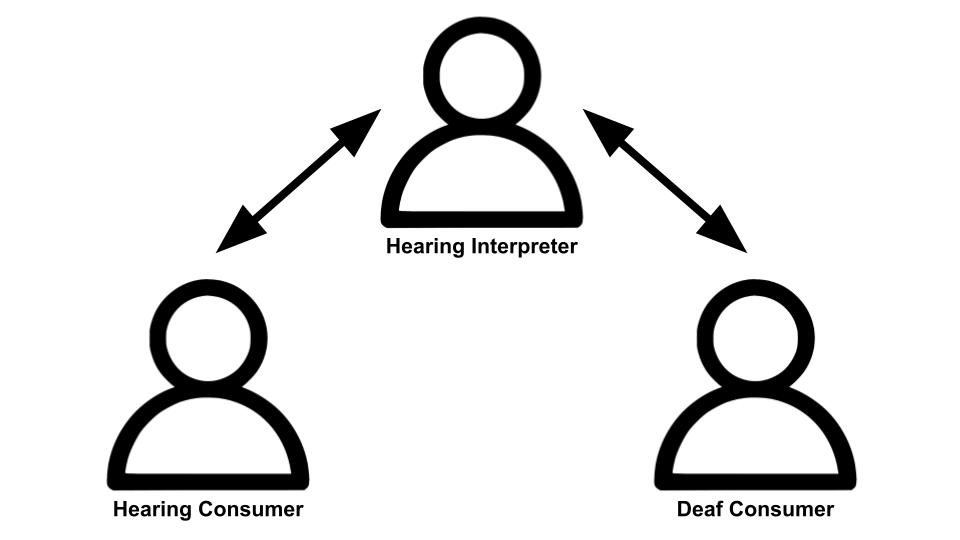
Let’s learn a bit about the lingo first!
Let’s begin!
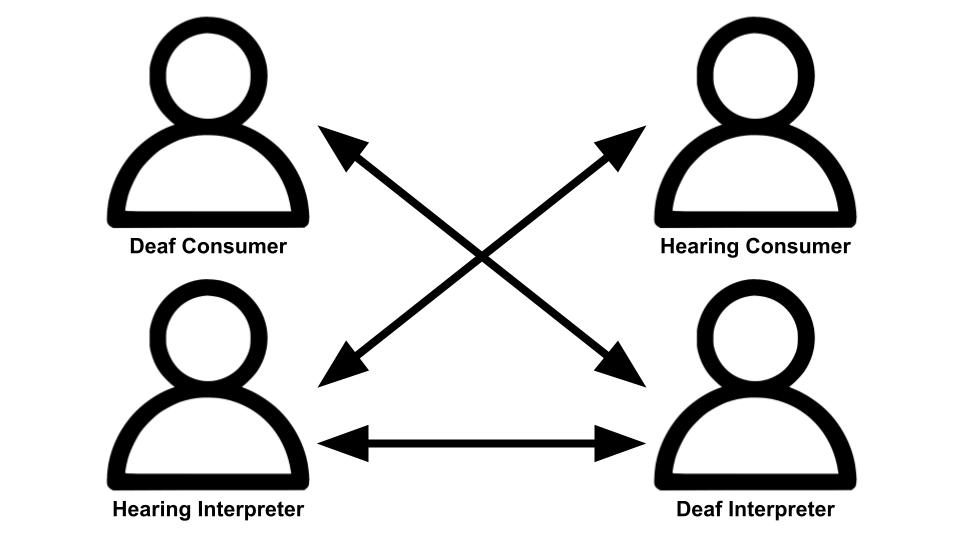
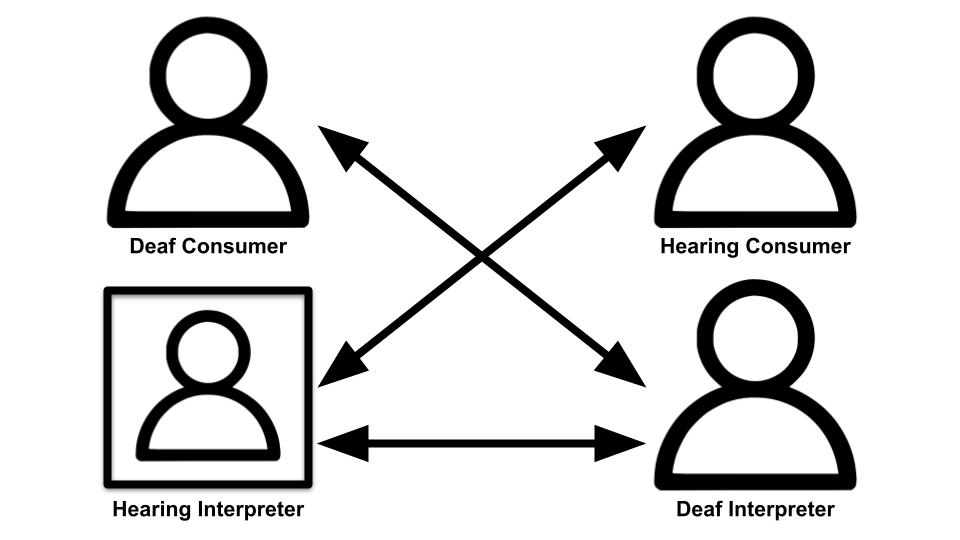
DI On-site with Remote HI
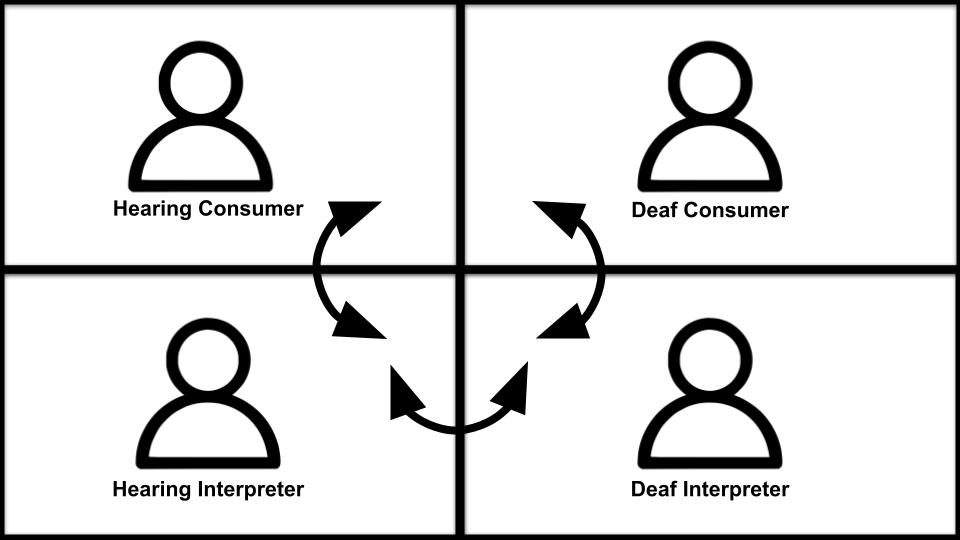
On-Site Interpreting with DI/HI Team
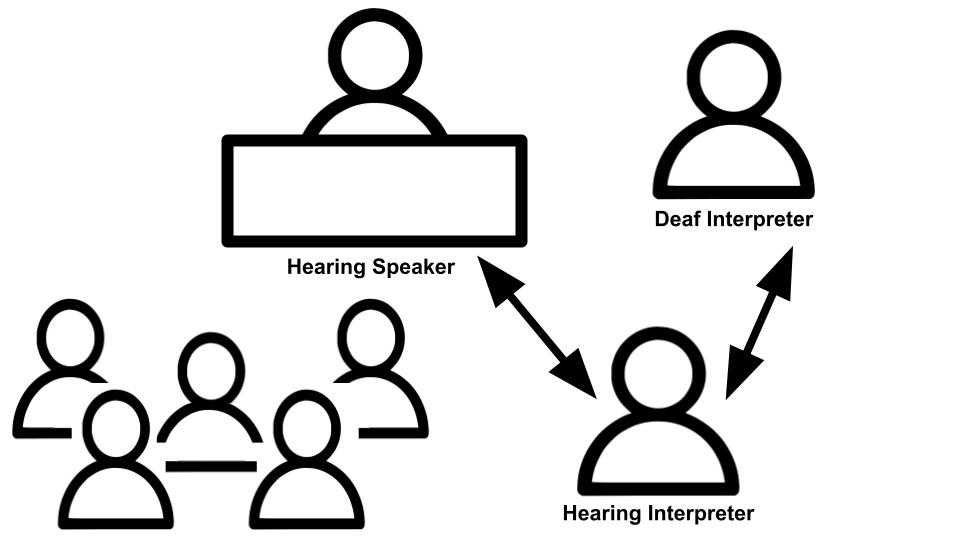
**NOTE: This model can be used for live audience as pictured, or for filmed sessions where the cameraperson(s) will film the speaker along with the DI on the platform. This model is the best practice for any presentations, public service announcements, press conferences, and more!
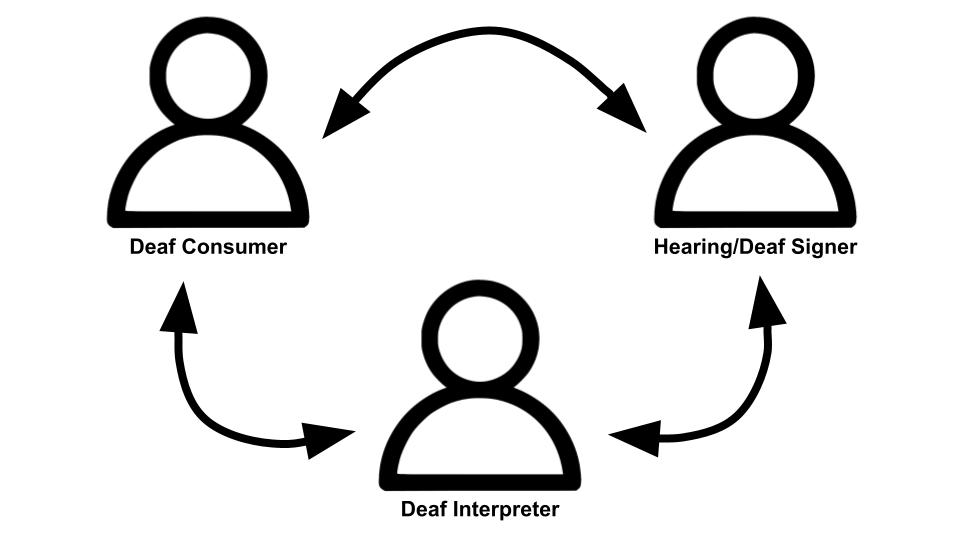
Now, that’s what we call 100% access!
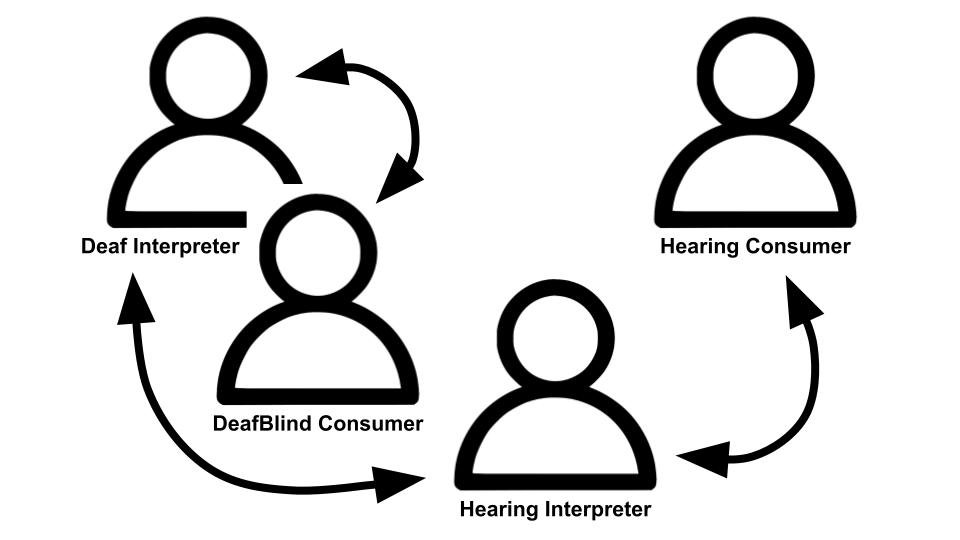
DI/HI TEAM USING TACTILE/PROTACTILE COMMUNICATIONS
THIS IS DEAF-CENTERED, EQUITY-BASED INTERPRETING.
Designed with 🤟🏻 by Eyeth Studios. a Deaf-owned company